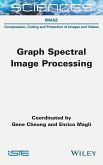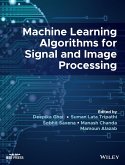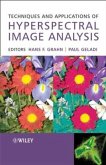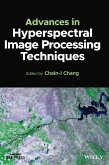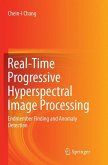Bing Zhang
Machine Learning-Based Hyperspectral Image Processing
Bing Zhang
Machine Learning-Based Hyperspectral Image Processing
- Gebundenes Buch
- Merkliste
- Auf die Merkliste
- Bewerten Bewerten
- Teilen
- Produkt teilen
- Produkterinnerung
- Produkterinnerung
An authoritative deep dive into the most recent machine learning approaches to hyperspectral remote sensing image processing In Machine Learning-Based Hyperspectral Image Processing, distinguished researcher Dr. Bing Zhang delivers an up-to-date discussion of machine learning-based approaches to hyperspectral image analysis. The author comprehensively reviews machine learning approaches to hyperspectral image denoising and super-resolution tasks, offering coverage of a variety of perspectives. Dr. Zhang also explores the most recent research on machine learning hyperspectral unmixing methods…mehr
Andere Kunden interessierten sich auch für
![Quantum Image Processing in Practice Quantum Image Processing in Practice]() Artyom M GrigoryanQuantum Image Processing in Practice135,99 €
Artyom M GrigoryanQuantum Image Processing in Practice135,99 €![Digital Signal and Image Processing Using Matlab, Volume 3 Digital Signal and Image Processing Using Matlab, Volume 3]() Gérard BlanchetDigital Signal and Image Processing Using Matlab, Volume 3159,99 €
Gérard BlanchetDigital Signal and Image Processing Using Matlab, Volume 3159,99 €![Graph Spectral Image Processing Graph Spectral Image Processing]() Gene CheungGraph Spectral Image Processing159,99 €
Gene CheungGraph Spectral Image Processing159,99 €![Machine Learning Algorithms for Signal and Image Processing Machine Learning Algorithms for Signal and Image Processing]() SL TripathiMachine Learning Algorithms for Signal and Image Processing144,99 €
SL TripathiMachine Learning Algorithms for Signal and Image Processing144,99 €![Techniques and Applications of Hyperspectral Image Analysis Techniques and Applications of Hyperspectral Image Analysis]() Hans Grahn (ed.) / Paul GeladiTechniques and Applications of Hyperspectral Image Analysis203,99 €
Hans Grahn (ed.) / Paul GeladiTechniques and Applications of Hyperspectral Image Analysis203,99 €![Advances in Hyperspectral Image Processing Techniques Advances in Hyperspectral Image Processing Techniques]() CI ChangAdvances in Hyperspectral Image Processing Techniques157,99 €
CI ChangAdvances in Hyperspectral Image Processing Techniques157,99 €![Real-Time Progressive Hyperspectral Image Processing Real-Time Progressive Hyperspectral Image Processing]() Chein-I ChangReal-Time Progressive Hyperspectral Image Processing98,99 €
Chein-I ChangReal-Time Progressive Hyperspectral Image Processing98,99 €-
-
-
An authoritative deep dive into the most recent machine learning approaches to hyperspectral remote sensing image processing In Machine Learning-Based Hyperspectral Image Processing, distinguished researcher Dr. Bing Zhang delivers an up-to-date discussion of machine learning-based approaches to hyperspectral image analysis. The author comprehensively reviews machine learning approaches to hyperspectral image denoising and super-resolution tasks, offering coverage of a variety of perspectives. Dr. Zhang also explores the most recent research on machine learning hyperspectral unmixing methods and hyperspectral image classification. He explains the algorithms used for hyperspectral image target and change detection, as well. Readers will also find: * A thorough introduction to the novel concept of applying advanced machine learning techniques to the analysis of hyperspectral imagery * Comprehensive explorations of the most recent developments in this technology and its applications * Practical discussions of how to effectively process and extract valuable insights from hyperspectral data * Complete treatments of a variety of hyperspectral remote sensing image processing tasks, including classification, target detection, and change detection. Perfect for postgraduate students and research scientists with an interest in the subject, Machine Learning-Based Hyperspectral Image Processing will also benefit researchers, academicians, and students engaged in machine learning-based approaches to image analysis.
Produktdetails
- Produktdetails
- Verlag: Wiley
- Seitenzahl: 768
- Erscheinungstermin: 16. Dezember 2025
- Englisch
- ISBN-13: 9781394267859
- ISBN-10: 1394267851
- Artikelnr.: 72552561
- Herstellerkennzeichnung
- Libri GmbH
- Europaallee 1
- 36244 Bad Hersfeld
- gpsr@libri.de
- Verlag: Wiley
- Seitenzahl: 768
- Erscheinungstermin: 16. Dezember 2025
- Englisch
- ISBN-13: 9781394267859
- ISBN-10: 1394267851
- Artikelnr.: 72552561
- Herstellerkennzeichnung
- Libri GmbH
- Europaallee 1
- 36244 Bad Hersfeld
- gpsr@libri.de
Bing Zhang, PhD, is Full Professor and Deputy Director of the Aerospace Information Research Institute, CAS. He has authored over 300 publications and currently serves as the Chief Editor for the Chinese Journal of Remote Sensing and Associate Editor for the IEEE Transactions on Geoscience and Remote Sensing.
About the Editors
List of Contributors
Preface
1. Chapter1-Review for Machine Learning-Based Hyperspectral Image Analysis
1.1 Overview
1.2 Denoising
1.3 Super-resolution
1.4 Unmixing
1.5 Classification
1.6 Target Detection
1.7 Change Detection
1.8 Experimental Datasets
1.9 Chapter Arrangement and Writing Purpose
2. Chapter2-Hyperspectral Image Denoising Based on Low-Rank Regularization
2.1 Introduction
2.2 Model-driven Approaches
2.3 Data-driven Approaches
2.4 Conclusion and Outlook
3. Chapter3-Hyperspectral Image Denoising Based on Tensor Models
3.1 Introduction
3.2 HSI Construction
3.3 Tensor Modelling-based Reconstruction Methods
3.4 Numerical Experiments
3.5 Conclusion
4. Chapter4-Hyperspectral Image Denoising Based on Spatial-Spectral Joint
Constraints
4.1 Non-Local Means Low-Rank Approximation
4.2 Wavelet-Based Block Low-Rank Representations
4.3 Conclusion
5. Chapter5-Hyperspectral Image Reconstruction Based on Spectral
Super-resolution
5.1 Introduction
5.2 Experimental Datasets and Evaluation Indicators
5.3 A learning subpixel super-resolution model based on coupled dictionary
5.4 A collaborative spectral-super-resolution model based on adaptive
learning
5.5 Conclusion
6. Chapter6-Hyperspectral Image Reconstruction Based on Supervised and
Semi-Supervised Learning
6.1 Introduction
6.2 Full Supervised HSI SR
6.3 Weakly Supervised HSI SR
6.4 Self-Supervised HSI SR
6.5 Blind HSI SR
6.6 Conclusion and Discussion
7. Chapter7-Hyperspectral Image Reconstruction Based on Unsupervised
Learning
7.1 Introduction
7.2 Problem Formulation
7.3 Unsupervised Hyperspectral Image Super-Resolution with Dirichlet-Net
7.4 Unsupervised and Unregistered Hyperspectral Image Super-Resolution
7.5 Improving SR Performance with Endmember Assisted Camera Response
Function Learning
7.6 Conclusions
8. Chapter8-Hyperspectral Image Reconstruction Based on Adaptive Learning
8.1 Introduction
8.2 Problem Formulation
8.3 Numerical Model-Guided Nonlinear Spectral Unmixing
8.4 Experiment and Results
8.5 Conclusion
9. Chapter9-Hyperspectral Unmixing With Nonnegative Matrix Factorization
9.1 Introduction
9.2 Methodologies
9.3 Experiments
9.4 Conclusion
10. Chapter10-Hyperspectral Unmixing Based on Low-rank Representation and
Sparse Constraints
10.1 Introduction
10.2 Linear Unmixing Algorithms
10.3 Hybrid Unmixing Algorithms
10.4 Experiments
10.5 Conclusions
11. Chapter11-Endmember purification and Endmember selection
11.1 Introduction
11.2 Endmember Purification
11.3 Unmixing with Geographic Knowledge Graph
11.4 Experimental Results and Analysis
11.5 Conclusion
12. Chapter12-Hyperspectral Unmixing Based on Deep Autoencoder Networks
12.1 Introduction
12.2 Methodologies
12.3 Experimental results
12.4 Conclusion
12.5 Discussion
13. Chapter13-Numerical Model-Guided Nonlinear Spectral Unmixing
13.1 Introduction
13.2 Nonlinear Mixture Models and Extensions
13.3 Numerical Model-Guided Nonlinear Spectral Unmixing
13.4 Conclusions
14. Chapter14-Spatial-Spectral Gabor-based Hyperspectral Image
Classification
14.1 Spatial-Spectral Gabor Feature Extraction
14.2 Pixel-wise Gabor Features for Hyperspectral Image Classification
14.3 Superpixel-wise Gabor Features for HSI Classification
15. Chapter15-Domain Adaptation for Hyperspectral Image Classification
15.1 Basic Concepts of Domain Adaptation
15.2 Domain Adaptation for Hyperspectral Image Classification
15.3 Deep Domain Adaptation-based Hyperspectral Image Classification
15.4 Conclusion
16. Chapter16-Unsupervised Domain Adaptation for Classification of
Hyperspectral Images
16.1 Introduction
16.2 Unsupervised Domain Adaptation Problem
16.3 Traditional Unsupervised Domain Adaptation Methods
16.4 Deep Learning Based Unsupervised Domain Adaptation Methods
16.5 Experimental Results and Analysis
17. Chapter17-Lightweight models for Hyperspectral Image Classification
17.1 Introduction
17.2 Lightweight Feature Extraction-based hyperspectral Image
Classification
17.3 Experimental Results and Analysis
17.4 Conclusion
18. Chapter18-Ensemble Method Based Hyperspectral Image Classification
18.1 Background
18.2 Introduction to Ensemble Learning
18.3 Ensemble Learning in HSI Classification
18.4 Conclusion
19. Chapter19-Spectral-Spatial Hyperspectral Image Classification Based on
Sparse Representation
19.1 Introduction
19.2 Related Models Description
19.3 Hyperspectral Image Classification Based on Sparse Representation
19.4 Experimental Results and Analysis
20. Chapter20-Hyperspectral Image Classification with Limited Samples
20.1 Introduction
20.2 Method
20.3 Experimental Results
21. Chapter21-Constrained Energy Minimization based Hyperspectral Image
Target Detection
21.1 Introduction
21.2 Overview of CEM
21.3 CEM-based methods
21.4 Conclusions
22. Chapter22-Target Deteciton Using Multi-Domain Features in Hyperspectral
Imagery
22.1 Introduction
22.2 Related Works
22.3 The Proposed Detection Methodology
22.4 Experiments and Analysis
22.5 Conclusion
23. Chapter23-Weakly Supervised Learning-based Hyperspectral Image Anomaly
Target Detection
23.1 Introduction
23.2 Weakly Supervised Hyperspectral Anomaly Detection (WSLRR)
23.3 Weakly Supervised Hyperspectral Target Detection (BLTSC)
23.4 Rank-Aware Hyperspectral Band Selection (R-GAN)
23.5 Conclusions
24. Chapter24-Hyperspectral anomaly detection via background-separable
model
24.1 Hyperspectral Anomaly Detection Using Dual Window Density
24.2 Hyperspectral Anomaly Detection Using Reconstruction Fusion of
Quaternion Frequency Domain Analysis
24.3 Ensemble Entropy Metric for Hyperspectral Anomaly Detection
25. Chapter25-Spectral Change Analysis for Multitemporal Change Detection
in Hyperspectral Remote Sensing Images
25.1 Introduction
25.2 Related works
25.3 Spectral Change Analysis in Hyperspectral images
25.4 Experimental setup
25.5 Results and Analysis
25.6 Conclusion
26. Chapter26-Challenges and Future Directions
26.1 Challenges and Future Directions in Hyperspectral Image Denoising
26.2 Challenges and Future Directions in Hyperspectral (HS) and
Multispectral (MS) Image Fusion
26.3 Challenges and Future Directions in NMF-Based Hyperspectral Unmixing
26.4 Challenges and Future Directions in Knowledge Graph-Enhanced
Hyperspectral Unmixing
26.5 Challenges and Future Directions in Numerical Model-Guided Nonlinear
Hyperspectral Unmixing
26.6 Challenges and Future Directions in Hyperspectral Image Classification
26.7 Chapter on Challenges and Future Directions in Hyperspectral Target
Detection
Index
List of Contributors
Preface
1. Chapter1-Review for Machine Learning-Based Hyperspectral Image Analysis
1.1 Overview
1.2 Denoising
1.3 Super-resolution
1.4 Unmixing
1.5 Classification
1.6 Target Detection
1.7 Change Detection
1.8 Experimental Datasets
1.9 Chapter Arrangement and Writing Purpose
2. Chapter2-Hyperspectral Image Denoising Based on Low-Rank Regularization
2.1 Introduction
2.2 Model-driven Approaches
2.3 Data-driven Approaches
2.4 Conclusion and Outlook
3. Chapter3-Hyperspectral Image Denoising Based on Tensor Models
3.1 Introduction
3.2 HSI Construction
3.3 Tensor Modelling-based Reconstruction Methods
3.4 Numerical Experiments
3.5 Conclusion
4. Chapter4-Hyperspectral Image Denoising Based on Spatial-Spectral Joint
Constraints
4.1 Non-Local Means Low-Rank Approximation
4.2 Wavelet-Based Block Low-Rank Representations
4.3 Conclusion
5. Chapter5-Hyperspectral Image Reconstruction Based on Spectral
Super-resolution
5.1 Introduction
5.2 Experimental Datasets and Evaluation Indicators
5.3 A learning subpixel super-resolution model based on coupled dictionary
5.4 A collaborative spectral-super-resolution model based on adaptive
learning
5.5 Conclusion
6. Chapter6-Hyperspectral Image Reconstruction Based on Supervised and
Semi-Supervised Learning
6.1 Introduction
6.2 Full Supervised HSI SR
6.3 Weakly Supervised HSI SR
6.4 Self-Supervised HSI SR
6.5 Blind HSI SR
6.6 Conclusion and Discussion
7. Chapter7-Hyperspectral Image Reconstruction Based on Unsupervised
Learning
7.1 Introduction
7.2 Problem Formulation
7.3 Unsupervised Hyperspectral Image Super-Resolution with Dirichlet-Net
7.4 Unsupervised and Unregistered Hyperspectral Image Super-Resolution
7.5 Improving SR Performance with Endmember Assisted Camera Response
Function Learning
7.6 Conclusions
8. Chapter8-Hyperspectral Image Reconstruction Based on Adaptive Learning
8.1 Introduction
8.2 Problem Formulation
8.3 Numerical Model-Guided Nonlinear Spectral Unmixing
8.4 Experiment and Results
8.5 Conclusion
9. Chapter9-Hyperspectral Unmixing With Nonnegative Matrix Factorization
9.1 Introduction
9.2 Methodologies
9.3 Experiments
9.4 Conclusion
10. Chapter10-Hyperspectral Unmixing Based on Low-rank Representation and
Sparse Constraints
10.1 Introduction
10.2 Linear Unmixing Algorithms
10.3 Hybrid Unmixing Algorithms
10.4 Experiments
10.5 Conclusions
11. Chapter11-Endmember purification and Endmember selection
11.1 Introduction
11.2 Endmember Purification
11.3 Unmixing with Geographic Knowledge Graph
11.4 Experimental Results and Analysis
11.5 Conclusion
12. Chapter12-Hyperspectral Unmixing Based on Deep Autoencoder Networks
12.1 Introduction
12.2 Methodologies
12.3 Experimental results
12.4 Conclusion
12.5 Discussion
13. Chapter13-Numerical Model-Guided Nonlinear Spectral Unmixing
13.1 Introduction
13.2 Nonlinear Mixture Models and Extensions
13.3 Numerical Model-Guided Nonlinear Spectral Unmixing
13.4 Conclusions
14. Chapter14-Spatial-Spectral Gabor-based Hyperspectral Image
Classification
14.1 Spatial-Spectral Gabor Feature Extraction
14.2 Pixel-wise Gabor Features for Hyperspectral Image Classification
14.3 Superpixel-wise Gabor Features for HSI Classification
15. Chapter15-Domain Adaptation for Hyperspectral Image Classification
15.1 Basic Concepts of Domain Adaptation
15.2 Domain Adaptation for Hyperspectral Image Classification
15.3 Deep Domain Adaptation-based Hyperspectral Image Classification
15.4 Conclusion
16. Chapter16-Unsupervised Domain Adaptation for Classification of
Hyperspectral Images
16.1 Introduction
16.2 Unsupervised Domain Adaptation Problem
16.3 Traditional Unsupervised Domain Adaptation Methods
16.4 Deep Learning Based Unsupervised Domain Adaptation Methods
16.5 Experimental Results and Analysis
17. Chapter17-Lightweight models for Hyperspectral Image Classification
17.1 Introduction
17.2 Lightweight Feature Extraction-based hyperspectral Image
Classification
17.3 Experimental Results and Analysis
17.4 Conclusion
18. Chapter18-Ensemble Method Based Hyperspectral Image Classification
18.1 Background
18.2 Introduction to Ensemble Learning
18.3 Ensemble Learning in HSI Classification
18.4 Conclusion
19. Chapter19-Spectral-Spatial Hyperspectral Image Classification Based on
Sparse Representation
19.1 Introduction
19.2 Related Models Description
19.3 Hyperspectral Image Classification Based on Sparse Representation
19.4 Experimental Results and Analysis
20. Chapter20-Hyperspectral Image Classification with Limited Samples
20.1 Introduction
20.2 Method
20.3 Experimental Results
21. Chapter21-Constrained Energy Minimization based Hyperspectral Image
Target Detection
21.1 Introduction
21.2 Overview of CEM
21.3 CEM-based methods
21.4 Conclusions
22. Chapter22-Target Deteciton Using Multi-Domain Features in Hyperspectral
Imagery
22.1 Introduction
22.2 Related Works
22.3 The Proposed Detection Methodology
22.4 Experiments and Analysis
22.5 Conclusion
23. Chapter23-Weakly Supervised Learning-based Hyperspectral Image Anomaly
Target Detection
23.1 Introduction
23.2 Weakly Supervised Hyperspectral Anomaly Detection (WSLRR)
23.3 Weakly Supervised Hyperspectral Target Detection (BLTSC)
23.4 Rank-Aware Hyperspectral Band Selection (R-GAN)
23.5 Conclusions
24. Chapter24-Hyperspectral anomaly detection via background-separable
model
24.1 Hyperspectral Anomaly Detection Using Dual Window Density
24.2 Hyperspectral Anomaly Detection Using Reconstruction Fusion of
Quaternion Frequency Domain Analysis
24.3 Ensemble Entropy Metric for Hyperspectral Anomaly Detection
25. Chapter25-Spectral Change Analysis for Multitemporal Change Detection
in Hyperspectral Remote Sensing Images
25.1 Introduction
25.2 Related works
25.3 Spectral Change Analysis in Hyperspectral images
25.4 Experimental setup
25.5 Results and Analysis
25.6 Conclusion
26. Chapter26-Challenges and Future Directions
26.1 Challenges and Future Directions in Hyperspectral Image Denoising
26.2 Challenges and Future Directions in Hyperspectral (HS) and
Multispectral (MS) Image Fusion
26.3 Challenges and Future Directions in NMF-Based Hyperspectral Unmixing
26.4 Challenges and Future Directions in Knowledge Graph-Enhanced
Hyperspectral Unmixing
26.5 Challenges and Future Directions in Numerical Model-Guided Nonlinear
Hyperspectral Unmixing
26.6 Challenges and Future Directions in Hyperspectral Image Classification
26.7 Chapter on Challenges and Future Directions in Hyperspectral Target
Detection
Index
About the Editors
List of Contributors
Preface
1. Chapter1-Review for Machine Learning-Based Hyperspectral Image Analysis
1.1 Overview
1.2 Denoising
1.3 Super-resolution
1.4 Unmixing
1.5 Classification
1.6 Target Detection
1.7 Change Detection
1.8 Experimental Datasets
1.9 Chapter Arrangement and Writing Purpose
2. Chapter2-Hyperspectral Image Denoising Based on Low-Rank Regularization
2.1 Introduction
2.2 Model-driven Approaches
2.3 Data-driven Approaches
2.4 Conclusion and Outlook
3. Chapter3-Hyperspectral Image Denoising Based on Tensor Models
3.1 Introduction
3.2 HSI Construction
3.3 Tensor Modelling-based Reconstruction Methods
3.4 Numerical Experiments
3.5 Conclusion
4. Chapter4-Hyperspectral Image Denoising Based on Spatial-Spectral Joint
Constraints
4.1 Non-Local Means Low-Rank Approximation
4.2 Wavelet-Based Block Low-Rank Representations
4.3 Conclusion
5. Chapter5-Hyperspectral Image Reconstruction Based on Spectral
Super-resolution
5.1 Introduction
5.2 Experimental Datasets and Evaluation Indicators
5.3 A learning subpixel super-resolution model based on coupled dictionary
5.4 A collaborative spectral-super-resolution model based on adaptive
learning
5.5 Conclusion
6. Chapter6-Hyperspectral Image Reconstruction Based on Supervised and
Semi-Supervised Learning
6.1 Introduction
6.2 Full Supervised HSI SR
6.3 Weakly Supervised HSI SR
6.4 Self-Supervised HSI SR
6.5 Blind HSI SR
6.6 Conclusion and Discussion
7. Chapter7-Hyperspectral Image Reconstruction Based on Unsupervised
Learning
7.1 Introduction
7.2 Problem Formulation
7.3 Unsupervised Hyperspectral Image Super-Resolution with Dirichlet-Net
7.4 Unsupervised and Unregistered Hyperspectral Image Super-Resolution
7.5 Improving SR Performance with Endmember Assisted Camera Response
Function Learning
7.6 Conclusions
8. Chapter8-Hyperspectral Image Reconstruction Based on Adaptive Learning
8.1 Introduction
8.2 Problem Formulation
8.3 Numerical Model-Guided Nonlinear Spectral Unmixing
8.4 Experiment and Results
8.5 Conclusion
9. Chapter9-Hyperspectral Unmixing With Nonnegative Matrix Factorization
9.1 Introduction
9.2 Methodologies
9.3 Experiments
9.4 Conclusion
10. Chapter10-Hyperspectral Unmixing Based on Low-rank Representation and
Sparse Constraints
10.1 Introduction
10.2 Linear Unmixing Algorithms
10.3 Hybrid Unmixing Algorithms
10.4 Experiments
10.5 Conclusions
11. Chapter11-Endmember purification and Endmember selection
11.1 Introduction
11.2 Endmember Purification
11.3 Unmixing with Geographic Knowledge Graph
11.4 Experimental Results and Analysis
11.5 Conclusion
12. Chapter12-Hyperspectral Unmixing Based on Deep Autoencoder Networks
12.1 Introduction
12.2 Methodologies
12.3 Experimental results
12.4 Conclusion
12.5 Discussion
13. Chapter13-Numerical Model-Guided Nonlinear Spectral Unmixing
13.1 Introduction
13.2 Nonlinear Mixture Models and Extensions
13.3 Numerical Model-Guided Nonlinear Spectral Unmixing
13.4 Conclusions
14. Chapter14-Spatial-Spectral Gabor-based Hyperspectral Image
Classification
14.1 Spatial-Spectral Gabor Feature Extraction
14.2 Pixel-wise Gabor Features for Hyperspectral Image Classification
14.3 Superpixel-wise Gabor Features for HSI Classification
15. Chapter15-Domain Adaptation for Hyperspectral Image Classification
15.1 Basic Concepts of Domain Adaptation
15.2 Domain Adaptation for Hyperspectral Image Classification
15.3 Deep Domain Adaptation-based Hyperspectral Image Classification
15.4 Conclusion
16. Chapter16-Unsupervised Domain Adaptation for Classification of
Hyperspectral Images
16.1 Introduction
16.2 Unsupervised Domain Adaptation Problem
16.3 Traditional Unsupervised Domain Adaptation Methods
16.4 Deep Learning Based Unsupervised Domain Adaptation Methods
16.5 Experimental Results and Analysis
17. Chapter17-Lightweight models for Hyperspectral Image Classification
17.1 Introduction
17.2 Lightweight Feature Extraction-based hyperspectral Image
Classification
17.3 Experimental Results and Analysis
17.4 Conclusion
18. Chapter18-Ensemble Method Based Hyperspectral Image Classification
18.1 Background
18.2 Introduction to Ensemble Learning
18.3 Ensemble Learning in HSI Classification
18.4 Conclusion
19. Chapter19-Spectral-Spatial Hyperspectral Image Classification Based on
Sparse Representation
19.1 Introduction
19.2 Related Models Description
19.3 Hyperspectral Image Classification Based on Sparse Representation
19.4 Experimental Results and Analysis
20. Chapter20-Hyperspectral Image Classification with Limited Samples
20.1 Introduction
20.2 Method
20.3 Experimental Results
21. Chapter21-Constrained Energy Minimization based Hyperspectral Image
Target Detection
21.1 Introduction
21.2 Overview of CEM
21.3 CEM-based methods
21.4 Conclusions
22. Chapter22-Target Deteciton Using Multi-Domain Features in Hyperspectral
Imagery
22.1 Introduction
22.2 Related Works
22.3 The Proposed Detection Methodology
22.4 Experiments and Analysis
22.5 Conclusion
23. Chapter23-Weakly Supervised Learning-based Hyperspectral Image Anomaly
Target Detection
23.1 Introduction
23.2 Weakly Supervised Hyperspectral Anomaly Detection (WSLRR)
23.3 Weakly Supervised Hyperspectral Target Detection (BLTSC)
23.4 Rank-Aware Hyperspectral Band Selection (R-GAN)
23.5 Conclusions
24. Chapter24-Hyperspectral anomaly detection via background-separable
model
24.1 Hyperspectral Anomaly Detection Using Dual Window Density
24.2 Hyperspectral Anomaly Detection Using Reconstruction Fusion of
Quaternion Frequency Domain Analysis
24.3 Ensemble Entropy Metric for Hyperspectral Anomaly Detection
25. Chapter25-Spectral Change Analysis for Multitemporal Change Detection
in Hyperspectral Remote Sensing Images
25.1 Introduction
25.2 Related works
25.3 Spectral Change Analysis in Hyperspectral images
25.4 Experimental setup
25.5 Results and Analysis
25.6 Conclusion
26. Chapter26-Challenges and Future Directions
26.1 Challenges and Future Directions in Hyperspectral Image Denoising
26.2 Challenges and Future Directions in Hyperspectral (HS) and
Multispectral (MS) Image Fusion
26.3 Challenges and Future Directions in NMF-Based Hyperspectral Unmixing
26.4 Challenges and Future Directions in Knowledge Graph-Enhanced
Hyperspectral Unmixing
26.5 Challenges and Future Directions in Numerical Model-Guided Nonlinear
Hyperspectral Unmixing
26.6 Challenges and Future Directions in Hyperspectral Image Classification
26.7 Chapter on Challenges and Future Directions in Hyperspectral Target
Detection
Index
List of Contributors
Preface
1. Chapter1-Review for Machine Learning-Based Hyperspectral Image Analysis
1.1 Overview
1.2 Denoising
1.3 Super-resolution
1.4 Unmixing
1.5 Classification
1.6 Target Detection
1.7 Change Detection
1.8 Experimental Datasets
1.9 Chapter Arrangement and Writing Purpose
2. Chapter2-Hyperspectral Image Denoising Based on Low-Rank Regularization
2.1 Introduction
2.2 Model-driven Approaches
2.3 Data-driven Approaches
2.4 Conclusion and Outlook
3. Chapter3-Hyperspectral Image Denoising Based on Tensor Models
3.1 Introduction
3.2 HSI Construction
3.3 Tensor Modelling-based Reconstruction Methods
3.4 Numerical Experiments
3.5 Conclusion
4. Chapter4-Hyperspectral Image Denoising Based on Spatial-Spectral Joint
Constraints
4.1 Non-Local Means Low-Rank Approximation
4.2 Wavelet-Based Block Low-Rank Representations
4.3 Conclusion
5. Chapter5-Hyperspectral Image Reconstruction Based on Spectral
Super-resolution
5.1 Introduction
5.2 Experimental Datasets and Evaluation Indicators
5.3 A learning subpixel super-resolution model based on coupled dictionary
5.4 A collaborative spectral-super-resolution model based on adaptive
learning
5.5 Conclusion
6. Chapter6-Hyperspectral Image Reconstruction Based on Supervised and
Semi-Supervised Learning
6.1 Introduction
6.2 Full Supervised HSI SR
6.3 Weakly Supervised HSI SR
6.4 Self-Supervised HSI SR
6.5 Blind HSI SR
6.6 Conclusion and Discussion
7. Chapter7-Hyperspectral Image Reconstruction Based on Unsupervised
Learning
7.1 Introduction
7.2 Problem Formulation
7.3 Unsupervised Hyperspectral Image Super-Resolution with Dirichlet-Net
7.4 Unsupervised and Unregistered Hyperspectral Image Super-Resolution
7.5 Improving SR Performance with Endmember Assisted Camera Response
Function Learning
7.6 Conclusions
8. Chapter8-Hyperspectral Image Reconstruction Based on Adaptive Learning
8.1 Introduction
8.2 Problem Formulation
8.3 Numerical Model-Guided Nonlinear Spectral Unmixing
8.4 Experiment and Results
8.5 Conclusion
9. Chapter9-Hyperspectral Unmixing With Nonnegative Matrix Factorization
9.1 Introduction
9.2 Methodologies
9.3 Experiments
9.4 Conclusion
10. Chapter10-Hyperspectral Unmixing Based on Low-rank Representation and
Sparse Constraints
10.1 Introduction
10.2 Linear Unmixing Algorithms
10.3 Hybrid Unmixing Algorithms
10.4 Experiments
10.5 Conclusions
11. Chapter11-Endmember purification and Endmember selection
11.1 Introduction
11.2 Endmember Purification
11.3 Unmixing with Geographic Knowledge Graph
11.4 Experimental Results and Analysis
11.5 Conclusion
12. Chapter12-Hyperspectral Unmixing Based on Deep Autoencoder Networks
12.1 Introduction
12.2 Methodologies
12.3 Experimental results
12.4 Conclusion
12.5 Discussion
13. Chapter13-Numerical Model-Guided Nonlinear Spectral Unmixing
13.1 Introduction
13.2 Nonlinear Mixture Models and Extensions
13.3 Numerical Model-Guided Nonlinear Spectral Unmixing
13.4 Conclusions
14. Chapter14-Spatial-Spectral Gabor-based Hyperspectral Image
Classification
14.1 Spatial-Spectral Gabor Feature Extraction
14.2 Pixel-wise Gabor Features for Hyperspectral Image Classification
14.3 Superpixel-wise Gabor Features for HSI Classification
15. Chapter15-Domain Adaptation for Hyperspectral Image Classification
15.1 Basic Concepts of Domain Adaptation
15.2 Domain Adaptation for Hyperspectral Image Classification
15.3 Deep Domain Adaptation-based Hyperspectral Image Classification
15.4 Conclusion
16. Chapter16-Unsupervised Domain Adaptation for Classification of
Hyperspectral Images
16.1 Introduction
16.2 Unsupervised Domain Adaptation Problem
16.3 Traditional Unsupervised Domain Adaptation Methods
16.4 Deep Learning Based Unsupervised Domain Adaptation Methods
16.5 Experimental Results and Analysis
17. Chapter17-Lightweight models for Hyperspectral Image Classification
17.1 Introduction
17.2 Lightweight Feature Extraction-based hyperspectral Image
Classification
17.3 Experimental Results and Analysis
17.4 Conclusion
18. Chapter18-Ensemble Method Based Hyperspectral Image Classification
18.1 Background
18.2 Introduction to Ensemble Learning
18.3 Ensemble Learning in HSI Classification
18.4 Conclusion
19. Chapter19-Spectral-Spatial Hyperspectral Image Classification Based on
Sparse Representation
19.1 Introduction
19.2 Related Models Description
19.3 Hyperspectral Image Classification Based on Sparse Representation
19.4 Experimental Results and Analysis
20. Chapter20-Hyperspectral Image Classification with Limited Samples
20.1 Introduction
20.2 Method
20.3 Experimental Results
21. Chapter21-Constrained Energy Minimization based Hyperspectral Image
Target Detection
21.1 Introduction
21.2 Overview of CEM
21.3 CEM-based methods
21.4 Conclusions
22. Chapter22-Target Deteciton Using Multi-Domain Features in Hyperspectral
Imagery
22.1 Introduction
22.2 Related Works
22.3 The Proposed Detection Methodology
22.4 Experiments and Analysis
22.5 Conclusion
23. Chapter23-Weakly Supervised Learning-based Hyperspectral Image Anomaly
Target Detection
23.1 Introduction
23.2 Weakly Supervised Hyperspectral Anomaly Detection (WSLRR)
23.3 Weakly Supervised Hyperspectral Target Detection (BLTSC)
23.4 Rank-Aware Hyperspectral Band Selection (R-GAN)
23.5 Conclusions
24. Chapter24-Hyperspectral anomaly detection via background-separable
model
24.1 Hyperspectral Anomaly Detection Using Dual Window Density
24.2 Hyperspectral Anomaly Detection Using Reconstruction Fusion of
Quaternion Frequency Domain Analysis
24.3 Ensemble Entropy Metric for Hyperspectral Anomaly Detection
25. Chapter25-Spectral Change Analysis for Multitemporal Change Detection
in Hyperspectral Remote Sensing Images
25.1 Introduction
25.2 Related works
25.3 Spectral Change Analysis in Hyperspectral images
25.4 Experimental setup
25.5 Results and Analysis
25.6 Conclusion
26. Chapter26-Challenges and Future Directions
26.1 Challenges and Future Directions in Hyperspectral Image Denoising
26.2 Challenges and Future Directions in Hyperspectral (HS) and
Multispectral (MS) Image Fusion
26.3 Challenges and Future Directions in NMF-Based Hyperspectral Unmixing
26.4 Challenges and Future Directions in Knowledge Graph-Enhanced
Hyperspectral Unmixing
26.5 Challenges and Future Directions in Numerical Model-Guided Nonlinear
Hyperspectral Unmixing
26.6 Challenges and Future Directions in Hyperspectral Image Classification
26.7 Chapter on Challenges and Future Directions in Hyperspectral Target
Detection
Index




